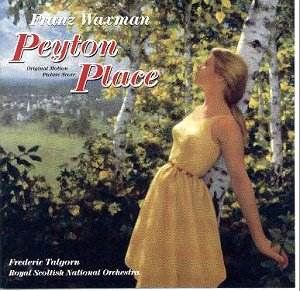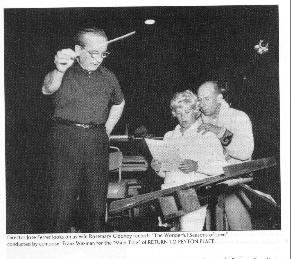| **************************************************************
EDITOR’s RECOMMENDATION September
2000
************************************************************** |
Franz WAXMAN
Peyton Place
 Frederick Talgorn conducting
the Royal Scottish National Orchestra
Frederick Talgorn conducting
the Royal Scottish National Orchestra
 VSD6070 on Varese Sarabande
{Run
time}
VSD6070 on Varese Sarabande
{Run
time}
Crotchet
Amazon
USA

Peyton Place, based on Grace Metalious's sensational, scandalous
(for its time), best-selling and immensely popular novel was filmed in 1957,
with Lana Turner, Hope Lange, Russ Tamblyn, Arthur Kennedy and Diane Varsi
in the central role of Alison MacKenkie. The film was nominated for nine
Academy Awards (although, incredibly, Franz Waxman's score was not,
and, in the event, all nine nominations were unsuccessful.) Peyton
Place went on to spawn three cinematic sequels and a 514 episode,
thrice-weekly, prime time ABC network television series starring Ryan O'Neal
and Mia Farrow. It might be said that Peyton Place launched the
soap opera. (One wonders if the similarly themed King's Row, with
that wonderful score by Korngold, might have done so if television was so
widespread in its day)
During the recording sessions for Peyton Place, the film's producer, Jerry
Wald wrote:- "Every musician on the lot is highly enthusiastic about
Franz Waxman's score for PEYTON PLACE, from Alfred Newman on down to the
members of the orchestra who recognize the score as a masterful job and a
great achievement in scoring. Mr Waxman is one of the few musicians I know
who does not think that the film is accompanying his music --- he makes his
music work for the picture. He adds dimension to the story-telling by his
sound effects in music. He also has the dramatic insight which tells him
when to stop the music. When people view the 'Chase in the Woods' for instance,
they will find that suddenly, at its height, the music stops and all that
is heard is the breathing of people involved in the chase and the natural
sounds in the woods at night."
As the composer's son, John Waxman, has perceptively said, "He (Franz Waxman)
captured the new England mood exquisitely." And another observer remarked,
"Franz Waxman's music is a lyric poem to the beauties and pitfalls of life
in nature and in spirit." All this is true; the music speaks eloquently of
life in a small, closely-knit community that is small town America -- and
of its surrounding countryside.
The difficulty with this score, especially for older generations, is
over-familiarity. The big theme that became the best-selling song, "The Wonderful
Seasons of Love" has been played over and over and over. [It was recorded
by Rosemary Clooney (lovely lady but who remembers her today?) for the film's
sequel Return to Peyton Place] Now, this valuable new recording
gives us the opportunity to hear it with open ears and really appreciate
its beauty and elegance -- and of the whole score.

The Main Title is rich indeed. A light but lively bell-like theme leads into
another theme that speaks of small town pride and its day-to-day busy activity
after which that lovely tune is stated, dressed in rich glowing harmonies.
This opening track closes with a cosy, tranquil, almost nocturnal pastoral
evocation and the mood is carried over into the opening of the following
cue, 'Entering Peyton Place'. Here, however, the tempo soon quickens and
Waxman presents a beautiful vivid evocation of the bustle of small town everyday
routine cleverly counterpointed with the main theme so that we are given
a sense of stability and warm affection. The following track 'Going to School'
is another gem - beginning as a fugue the music then becomes a jazzy, joyful,
carefree caper. But in 'After School' we realise that all is not sweetness
and light, shadows begin to manifest themselves and the big tune takes on
a sadder more reflective tinge. The music of this cue ends with lovely
introspective solos from violin, oboe and horn and a long-held sighing chord
on upper strings.
'Hilltop Scene' is another very impressive creation and at nearly seven minutes
duration the most significant cue of the album. It is, as would be expected,
predominantly pastoral but it encompasses contrasting moods. It opens playfully
with folk tune material and an air of nostalgia. The music even nods a little
towards Rodgers' Oklahoma! Then the pace slows, the music becomes pensive,
and a lovely horn passage suggests wide vistas. Waxman takes bits of his
main themes and weaves subtle variations with them embroidering into them
bird calls and other countryside evocations. Suddenly his music becomes strongly
influenced by the pastoral/mystical style of the English composer Ralph Vaughan
Williams. This beautiful cue ends with the big tune reasserting itself with
even more varied and rich harmonies.
'Rossi's Visit' is gentle, sweet romance with a saxophone solo adding to
its air of sadness and tingeing it with jazz blues. This colouring spills
over into 'After the Dance' that precedes 'The Rape', both speaking of beauty
and innocence betrayed. The music becomes turgid and sinister with the rape
music shot through with screeching, screaming brass. 'Chase in the Woods'
is chillingly evocative with some brilliant writing for pizzicato strings,
low woodwinds and brass. Notice how Waxman creates as much terror and tension
by employing just one, or a very few instruments, and by thinning out his
textures to silence [Some younger film music composers could learn a thing
or two by studying this cue!]
'Swimming Montage' is another significant cue lasting over five minutes.
This is contrastingly sunny music and somewhat Italian and I was reminded
of Respighi in his quieter pastoral moments. It has an appealing chirpiness
and again birdsong is apparent, at one point a woodpecker is insistent. Inventive
as ever with his big tune, it surges here to a triumphant romantic climax
with warm burnished horn calls.
'Constance's Story' is anguished and its pathos is communicated by solo cello
and lower strings. The next few tracks use material from the beginning of
the Main Title as associated with the town. 'Alison's Decision' has a heavy
tread, 'Leaving for New York' is equally full of regret and is laced with
a jazz blues. But it is 'Peyton Draftees' that is so richly evocative. The
town theme here has tragic overtones and is accompanied by bugle calls to
arms and snare drums. 'Honor Roll', with its heavy tolling bells, heavy tread
and bugle's Last Post, is an eloquent Requiem and a sadder statement of the
school music reminds us that youth has been cut short all too soon.
The air of tragic loss in 'Love Me, Michael' is gently brushed aside by harp
arpeggios to make way for an affirmatory restatement of the opening chords
of the Main Title that now becomes 'End Title'. The album closes with 'End
Credits' a rather subdued version of the big tune. This cue together with
'After the Dance' , 'Summer Montage' (warm and glistening -- and the only
cue I have not mentioned in the above analysis because it interrupts the
flow of the musical narrative) and 'Leaving for New York' are all world premier
recordings.
This underrated score is fully deserving of the detailed analysis I have
given above. It is beautifully and most sensitively performed by the RSNO
under Frederic Talgorn and I wish it all the success it deserves. The booklet,
by the way has insightful notes by Robert Townson and John Waxman plus an
interesting picture of the cast and crew of the film in addition to that
of Waxman conducting and included with this review.
Ian Lace

![]()
![]()
![]()
![]()
![]()
![]()
![]()
![]()
![]()
![]()
![]()
![]()
![]()
![]()
![]()
![]()